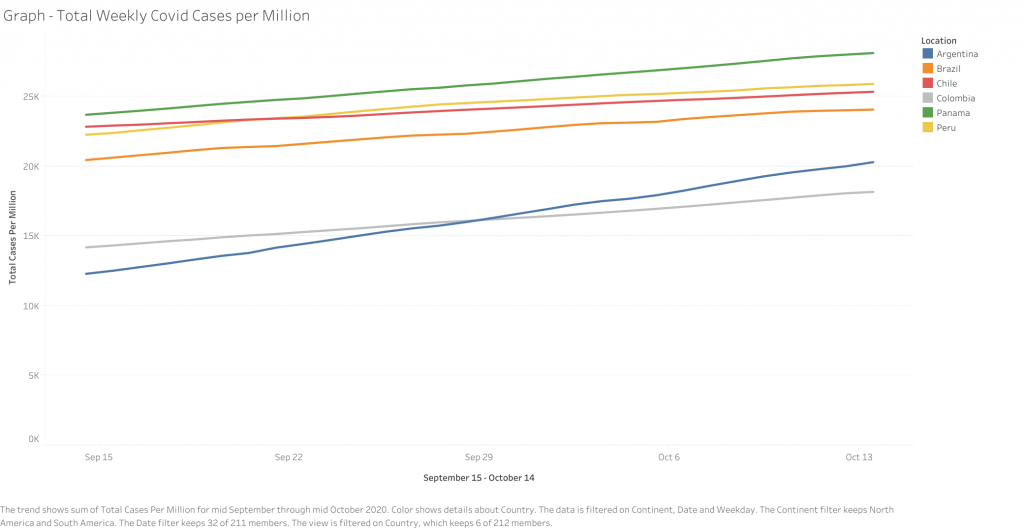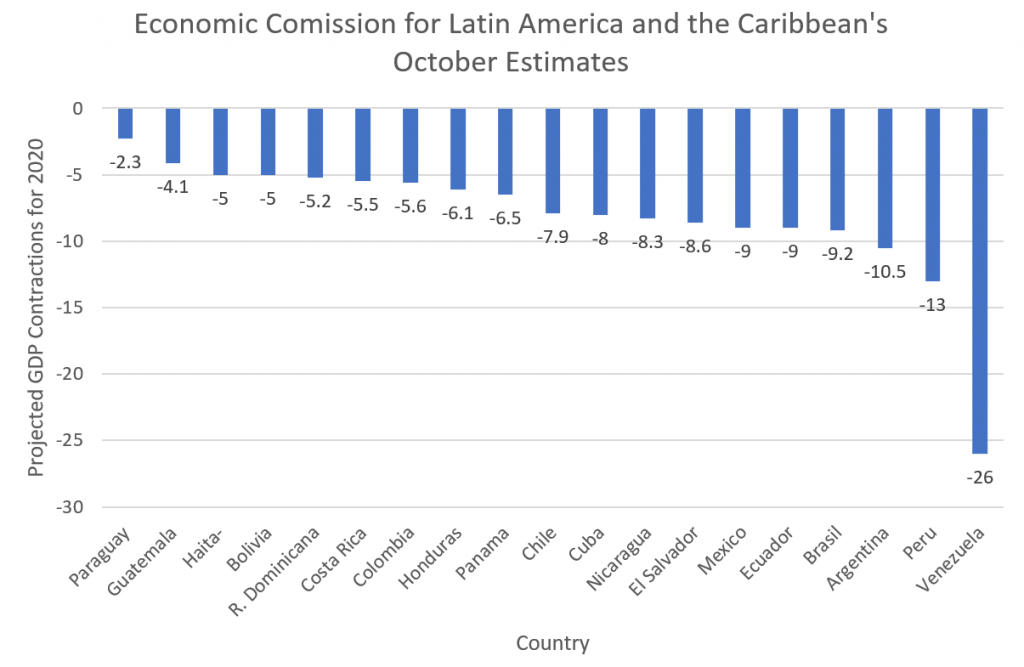What you should know
- The Pan American Health Organization raised concern over the spike in COVID-19 cases, especially among young people, as the region opens to international travel. Over the past 60 days, 11 countries and territories in the Caribbean have moved from moderate to intense transmission.
- The World Bank’s latest forecast predicts Latin American and Caribbean economies would not return to 2019 levels until 2023, a year behind most other countries.
- The region’s GDP is forecast to contract 9 percent in 2020, according to ECLAC. The deepest economic contractions: Venezuela (26 percent), Peru (13 percent), and Argentina (11 percent).
By the numbers
- Cases by country: Brazil (5,114,823) #3 worldwide, Colombia (924,098) #6 worldwide, Argentina (917,035) #7 worldwide, Peru (853,974) #8 worldwide, Mexico (825,340) #9 worldwide, Chile (485,372) #14 worldwide
- Prevalence rate (total cases per million people): Aruba (44,403) #3 worldwide, Panama (27,988) #7 worldwide, Peru (25,799) #9 worldwide, Chile (25,329) #10 worldwide, Brazil (24,014) #12 worldwide, Argentina (20,237) #17 worldwide
- Deaths per capita (deaths per million people): Peru (1,010) #2 worldwide, Bolivia (713) #6 worldwide, Brazil (709), #7 worldwide, Chile (700) #8 worldwide, Ecuador (691) #9 worldwide, Mexico (653) #11 worldwide
Quarantine + reopening plans
As COVID-19 spikes in specific countries, governments have announced more nuanced quarantine and reopening plans.
- Most of Cuba entered the final stage of the government’s reopening plan on October 12; however, not all restrictions will be eased. Havana will lift some restrictions but not enter the final stage.
- Popular Chilean beach destinations Viña del Mar and Valparaíso have lifted quarantine measures after four months.
- Campeche continues to be the only state to be classified as green (low risk) under Mexico’s four light traffic system. Seven states will reimplement restrictions while five states will ease restrictions.
- Argentine President Alberto Fernández announced circulation restrictions and other quarantine measures in 18 provinces for the next two weeks as COVID-19 continues to spread beyond Buenos Aires. Meanwhile, Buenos Aires city reopened public schools. But students and teachers are not obliged to return to school, and each institution will design its own operating scheme based on available resources and an epidemiological traffic light system.
International travel restrictions
- The World Travel and Tourism Council awarded Safe Travel Stamps to the Bahamas, El Salvador, Guatemala, Paraguay, Peru, for their implementation of standardized health and hygiene protocols. The full list is available here.
- Bolivia strengthened its health controls along the entire Bolivian-Argentine border, following a surge in cases in the border region of Tarija. Only residents or citizens may enter Bolivia from Argentina.
- Cuba will allow international flights to provinces that have entered the new normal phase of the government reopening plan, beginning October 15. The German airline Condor is expected to begin flights to Varadero on October 31.
- On October 15, Costa Rica will open beaches to the public and admit flights from Belize, El Salvador, Guatemala, Honduras, Nicaragua, and Panama.
- The government of St. Kitts and Nevis announced that it would open reopen its border in phases. Visitors will be permitted to travel to preapproved destinations and hotels beginning October 31.
Economies in focus
Economic impact
- Total agricultural exports from Nicaragua increased 16 percent from January to July over the previous year; although, exports of milk, leather, and cattle were down.
- Credit Suisse warned that 74 percent of investors believed Mexico’s investment-grade rating would be downgraded to junk. Mexico has held the coveted rating for the last two decades.
- Costa Rica’s economy contracted for the eighth consecutive month. Production decreased by 8 percent in August.
- Brazil’s service sector, which accounts for more than 60 percent of the country’s GDP, contracted 10 percent in August compared to the previous year.
Economic relief
- The Argentine Congress approved new tax incentives for its tech sector as the pandemic speeds up digitalization. The bill is expected to nearly double employment in the tech sector and increase tech service exports by $4 billion.
- The International Finance Corporation announced a partnership with the Guatemalan Agricultural Bank to provide a total of $20 million in financing to more than 1,000 micro, small, and medium-sized enterprises.
- Colombian President Iván Duque confirmed that the Program for the Support of Formal Employment will be extended until March 2021 and salaries for working women will be increased by 50 percent. The government has provided $855,000 in salary support through the program.
- The Inter-American Development Bank announced $200 million in loans to Brazil to support small and medium-sized enterprises through the Emergency Access to Credit Program.
Health + innovation
- Countries in the region continue to engage with the WHO COVAX mechanism for the fair distribution of COVID-19 vaccines. Mexico provided $180 million for the COVAX mechanism to guarantee vaccines for at least 20 percent of the population, focusing on doctors and vulnerable populations. Trinidad & Tobago also requested vaccines for 33 percent of the population from the COVAX initiative.
- On October 12, Nicolás Maduro said that Venezuela would begin testing one of the four Chinese vaccines on volunteers in the next few days. Venezuela previously received 2,000 Russian coronavirus Sputnik V vaccines, although there is little information about the progress of the clinical trial.
- Earlier this week, Bolivian laboratory Sigma Corporation announced a partnership with Russia to distribute the Sputnik V vaccine.
- The Colombian Technical Vice Minister of Health Juan Pablo Zárate announced that the government had set aside $213 million to purchase enough vaccines for 20 percent of the population.
A Message from PhRMA: Biopharmaceutical companies are sharing their knowledge and resources more than ever before to speed up the development of new medicines and vaccines to fight COVID-19. They’re working with doctors and hospitals on more than 1,600 clinical trials. Because science is how we get back to normal.
Country Focus
- Venezuela: Venezuelans are once again fleeing after COVID-19 lockdowns had temporarily slowed migration. During the pandemic, an estimated 106,000 Venezuelans returned from Colombia. Now, Colombian immigration officials expect 20,000 Venezuelans to come back to Colombia in the coming months.
- Bolivia: Sunday’s presidential election will come amid increased safety measures to limit the spread of COVID-19. To avoid crowds, voters will cast their ballots during specific time windows and be required to socially distance. Voting is mandatory for citizens over 18 residing in the country. This will be the first presidential election since disputed results led to then-President Evo Morales’ departure nearly one year ago.
- Cuba: Economy Minister Alejandro Gil said that the country must unify its dual currency system and multiple exchange rates to overcome the economic crisis as the country’s economy struggles under pressure from US sanctions and the global pandemic. Economists predict the move will cause triple inflation and bankruptcies but also stimulate domestic economic efficiency.
By the numbers (continued)
- Cases by country (continued): Ecuador (148,171), Bolivia (138,922), Panama (121,296), Dominican Republic (199,008), Guatemala (99,094), Costa Rica (90,238), Honduras (84,852)
- Prevalence rate (continued): Colombia (18,106), Costa Rica (17,668), Bahamas (13,094), Saint Martin (11,995), Bolivia (11,855), Dominican Republic (10,209), Suriname (8,624)
- Deaths per capita (continued): Panama (579), Colombia (551), Argentina (542), Aruba (309), Honduras (254), Costa Rica (220), Dominican Republic (201)
Quick take


